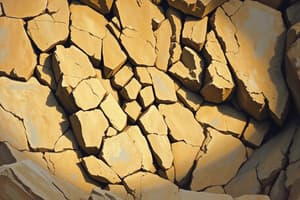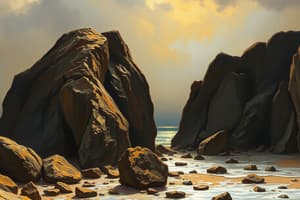Podcast
Questions and Answers
Welche Eigenschaft macht Granit zu einem beliebten Baustoff?
Welche Eigenschaft macht Granit zu einem beliebten Baustoff?
- Granit ist leicht zu bearbeiten
- Granit ist einfach zu beschaffen
- Granit ist sehr porös
- Granit ist widerstandsfähig gegen Verwitterung (correct)
Welcher Gesteinstyp entsteht durch die Umwandlung von bereits vorhandenen Gesteinen aufgrund von Hitze und Druck?
Welcher Gesteinstyp entsteht durch die Umwandlung von bereits vorhandenen Gesteinen aufgrund von Hitze und Druck?
- Sedimentgesteine
- Vulkanische Gesteine
- Magmatische Gesteine
- Metamorphe Gesteine (correct)
Welche Eigenschaft haben Sedimentgesteine, die sie für den Einsatz im Bauwesen attraktiv macht?
Welche Eigenschaft haben Sedimentgesteine, die sie für den Einsatz im Bauwesen attraktiv macht?
- Sie haben eine hohe Porosität
- Sie sind sehr hart und widerstandsfähig
- Sie sind sehr leicht
- Sie können leicht geschnitten und geformt werden (correct)
Welcher Gesteinstyp entsteht, wenn Magma oder Lava an der Erdoberfläche schnell abkühlt und erstarrt?
Welcher Gesteinstyp entsteht, wenn Magma oder Lava an der Erdoberfläche schnell abkühlt und erstarrt?
Welcher Gesteinstyp entsteht, wenn Magma langsam unter der Erdoberfläche abkühlt und kristallisiert?
Welcher Gesteinstyp entsteht, wenn Magma langsam unter der Erdoberfläche abkühlt und kristallisiert?
Welche Hauptanwendung hat Marmor als Baustoff?
Welche Hauptanwendung hat Marmor als Baustoff?
Welcher der folgenden Sätze beschreibt Marmor am besten?
Welcher der folgenden Sätze beschreibt Marmor am besten?
Was ist die Hauptkomponente von Sandstein?
Was ist die Hauptkomponente von Sandstein?
Was ist der Hauptzweck von Mörtel im Bauwesen?
Was ist der Hauptzweck von Mörtel im Bauwesen?
Welche der folgenden Formationen ist natürlichen Ursprungs?
Welche der folgenden Formationen ist natürlichen Ursprungs?
Was ist das Hauptmerkmal der Trockensteinmauerwerkstechnik?
Was ist das Hauptmerkmal der Trockensteinmauerwerkstechnik?
Wofür wird die Verblendkonstruktionstechnik hauptsächlich eingesetzt?
Wofür wird die Verblendkonstruktionstechnik hauptsächlich eingesetzt?
Flashcards are hidden until you start studying
Study Notes
Rocks and Masonry: A Comprehensive Guide
From ancient civilizations erecting monumental structures to modern engineers crafting highways and buildings, rocks and stones have played a pivotal role in shaping our world. This guide explores various aspects of these essential resources, including their classification, properties, applications in construction, and formation processes.
Types of Rocks
Igneous Rocks
Igneous rocks are formed from cooled, solidified molten rock known as magma or lava. There are two main types: intrusive and extrusive. Intrusive rocks, such as granite and gabbro, form when magma slowly cools and crystallizes beneath the Earth's surface. Extrusive rocks, like basalt and rhyolite, form when magma rapidly cools and solidifies at or near the Earth's surface.
Sedimentary Rocks
Sedimentary rocks are formed from the accumulation and compaction of organic or inorganic materials over time. Types include sandstone, limestone, and shale, which are often used in construction as they can easily be cut and shaped.
Metamorphic Rocks
Metamorphic rocks are formed from the transformation of pre-existing rocks due to heat and pressure. Examples include marble, slate, and gneiss.
Types of Stones
Granite
Granite is a common igneous rock often used in construction due to its durability and resistance to weathering. It can be polished to create attractive surfaces for countertops, flooring, and exterior cladding.
Marble
Marble is a metamorphic rock derived from limestone. It has high luster and is often used for decorative purposes, such as sculptures and architectural details.
Sandstone
Sandstone is a sedimentary rock composed primarily of sand-sized grains of minerals, rocks, and organic matter. It's often used in construction as a building material and for paving.
Building Materials
Rocks and stones have been used as building materials for thousands of years, thanks to their durability and strength. They're often used in conjunction with mortar, which is made from cement, sand, and water. The mixture binds the stones together, creating a strong and sturdy structure.
Rock Formations
Rock formations are unique geological features that can be found all over the world. Some are naturally occurring, such as mountains and canyons, while others are man-made, like quarries and mines. These formations can vary greatly in size, shape, and composition, making each one a fascinating piece of our planet's natural history.
Construction Methods
Dry Stone Masonry
This ancient technique involves building structures without the use of mortar or other binding agents. The stones are carefully selected and shaped to fit together seamlessly, creating a structure that's both sturdy and visually appealing.
Veneer Construction
In this method, a layer of stone is applied to the exterior of a building, often for aesthetic reasons. The stones are cut to fit around windows, doors, and other architectural features, creating a cohesive look.
Carved Stone
Carved stone refers to the art of shaping and cutting stone into decorative elements for buildings and other structures. This technique has been used for centuries, and can be seen in many of the world's most famous landmarks.
In conclusion, rocks and masonry have played a vital role in shaping our built environment and will continue to do so for generations to come. Understanding the different types of rocks, stones, and construction methods can help us appreciate the ingenuity and craftsmanship that goes into creating these enduring structures.
Studying That Suits You
Use AI to generate personalized quizzes and flashcards to suit your learning preferences.




